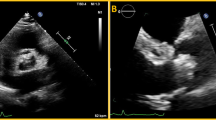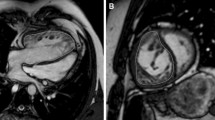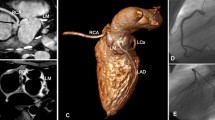Abstract
Objective: Prognosis in patients with surgically corrected (Senning or Mustard) transposition of the great arteries (TGA) depends mainly on right ventricular (RV) function and RV functional reserve. We examined the role of dobutamine stress in the early detection of RV dysfunction in asymptomatic or slightly symptomatic patients with TGA using magnetic resonance imaging (MRI). Design and patients: Twelve asymptomatic or slightly symptomatic patients with chronic RV pressure overload, surgically corrected (Mustard or Senning) TGA (age 22.8 (±3.4) years; New York Heart Association (NYHA) class I/II) and nine age matched healthy volunteers (age 27.3 (±4.4) years) were included. MRI was applied both at baseline and during dobutamine stress (start dose 5 μg/kg/min to maximum dose 15 μg/kg/min) to determine RV and left ventricular (LV) stroke volumes (SV) and ejection fraction (EF). Results: At baseline only RVEF was significantly higher in controls than in patients (71 (±9) vs. 57 (±10)%, p < 0.001), other RV parameters were not significantly different between the two examined groups: RVSV (86 (±21) vs. 72 (±27) ml, p = ns), RV end-diastolic volume (EDV) (123 (±37) vs. 123 (±33) ml, p = ns), and heart rate (61 (±10) vs. 69 (±14) bpm, p = ns), respectively. During dobutamine stress RVEF increased significantly both in controls and patients (20 (±16) vs. 17 (±18)%, p < 0.01 and p < 0.02 vs. rest, respectively), but stress RVEF was significantly higher in controls than in patients (85 (±3) vs. 66 (±7)%, p < 0.0001). RVSV increased significantly in controls (22 (±19)%, p < 0.02), and there was no significant increase in RVSV in patients (−10 (±28)%, p = ns). The controls showed no change in RVEDV (2 (±17)%, p = ns), but in patients a significant decrease in RVEDV (−24 (±15)%, p < 0.001) was observed. Maximal heart rate was significantly higher in patients than in controls (122 (±20) vs. 101 (±14) bpm, p < 0.02). Conclusion: In asymptomatic or slightly symptomatic patients with surgically corrected TGA dobutamine had a positive inotropic effect on RV, but the increased contractility was not accompanied by an appropriate increase in SV. Our data suggest inadequate RV filling in this category of patients, possibly due to rigid atrial baffles and compromised atrial function or decreased compliance due to RV hypertrophy.
Similar content being viewed by others
References
Dimas AP, Moodie DS, Sterba R, Gill CC. Long-term function of the morphologic right ventricle in adult patients with corrected transposition of the great arteries. Am Heart J 1989; 118: 526–530.
Warnes CA. Congenitally corrected transposition: the uncorrected misnomer. J Am Coll Cardiol 1996; 27: 1244–1245.
Paul MH, Wessel HU. Exercise studies in patients with transposition of the great arteries after atrial repair operations (Mustard/Senning). Pediatr Cardiol 1999; 20: 49–55.
Connelly MS, Liu PP, Williams WG, Webb GD, Robertson P, McLaughlin PR. Congenitally corrected transposition of the great arteries in the adult: functional status and complications. J Am Coll Cardiol 1996; 27: 1238–1243.
Graham TP, Jr. Ventricular performance in congenital heart disease. Circulation 1991; 84: 2259–2274.
Rebergen SA, Helbing WA, van der Wall EE, Maliepaard C, Chin JG, de Roos A. MR velocity mapping of tricuspid flow in healthy children and in patients who have undergone Mustard or Senning repair. Radiology 1995; 194: 505–512.
Helbing WA, Rebergen SA, Maliepaard C, Hansen B, Ottenkamp J, Reiber JH, de Roos A. Quantification of right ventricular function with magnetic resonance imaging in children with normal hearts and with congenital heart disease. Am Heart J 1995; 130: 828–837.
Rebergen SA, Niezen RA, Helbing WA, van der Wall EE, de Roos A. Cine gradient-echo MR imaging and MR velocity mapping in the evaluation of congenital heart disease. Radiographics 1996; 16: 467–481.
Marcus JT, Noordegraaf AV, De Vries PM, Van Rossum AC, Roseboom B, Heethaar RM, Postmus PE. MRI evaluation of right ventricular pressure overload in chronic obstructive pulmonary disease. J Magn Reson Imaging 1998; 8: 999–1005.
Pattynama PM, De Roos A, Van der Wall EE, Van Voorthuisen AE. Evaluation of cardiac function with magnetic resonance imaging. Am Heart J 1994; 128: 595–607.
Rebergen SA, van der Wall EE, Doornbos J, de Roos A. Magnetic resonance measurement of velocity and flow: technique, validation, and cardiovascular applications. Am Heart J 1993; 126: 1439–1456.
van Rugge FP, Holman ER, van der Wall EE, de Roos A, van der Laarse A, Bruschke AV. Quantitation of global and regional left ventricular function by cine magnetic resonance imaging during dobutamine stress in normal human subjects. Eur Heart J 1993; 14: 456–463.
Pennell DJ. Pharmacological cardiac stress: when and how? Nucl Med Commun 1994; 15: 578–585.
Dell'Italia LJ, Starling MR, Blumhardt R, Lasher JC, O'Rourke RA. Comparative effects of volume loading, dobutamine, and nitroprusside in patients with predominant right ventricular infarction. Circulation 1985; 72: 1327–1335.
Hines R. Right ventricular function and failure: a review. Yale J Biol Med 1991; 64: 295–307.
Gorcsan J, Murali S, Counihan PJ, Mandarino WA, Kormos RL. Right ventricular performance and contractile reserve in patients with severe heart failure. Assessment by pressure-area relations and association with outcome. Circulation 1996; 94: 3190–3197.
Greyson C, Garcia J, Mayr M, Schwartz GG. Effects of inotropic stimulation on energy metabolism and systolic function of ischemic right ventricle. Am J Physiol 1995; 268: 1821–1828.
Jerzewski A, Pattynama PM, Steendijk P, Leeuwenburgh BP, de Roos A, Baan J. Differential response of the right and left ventricle to beta-adrenergic stimulation: an echo planar MR study in intact animals. J Comput Assist Tomogr 1998; 22: 569–576.
Benson LN, Burns R, Schwaiger M, et al. Radionuclide angiographic evaluation of ventricular function in isolated congenitally corrected transposition of the great arteries. Am J Cardiol 1986; 58: 319–324.
Redington AN. The Mustard and Senning procedures: assessment of right ventricular performance. In: AN Redington, JB Brawn, JE Deanfield, RH Anderson. (editors) The right heart in congenital heart disease. London: Greenwich Medical Media, 1998; 197–201.
Oldershaw P. Assessment of right ventricular function and its role in clinical practice. Br Heart J 1992; 68: 12–15.
Lorenz CH, Walker ES, Graham TP, Jr, Powers TA. Right ventricular performance and mass by use of cine MRI late after atrial repair of transposition of the great arteries. Circulation 1995; 92:II 233–239.
Page E, Perrault H, Flore P, et al. Cardiac output response to dynamic exercise after atrial switch repair for transposition of the great arteries. Am J Cardiol 1996; 77: 892–895.
Matthys D, De Wolf D, Verhaaren H. Lack of increase in stroke volume during exercise in asymptomatic adolescents in sinus rhythm after intraatrial repair for simple transposition of the great arteries. Am J Cardiol 1996; 78: 595–596.
Author information
Authors and Affiliations
Rights and permissions
About this article
Cite this article
Tulevski, I.I., Lee, P.L., Groenink, M. et al. Dobutamine-induced increase of right ventricular contractility without increased stroke volume in adolescent patients with transposition of the great arteries: Evaluation with magnetic resonance imaging. Int J Cardiovasc Imaging 16, 471–478 (2000). https://doi.org/10.1023/A:1010692807154
Issue Date:
DOI: https://doi.org/10.1023/A:1010692807154




